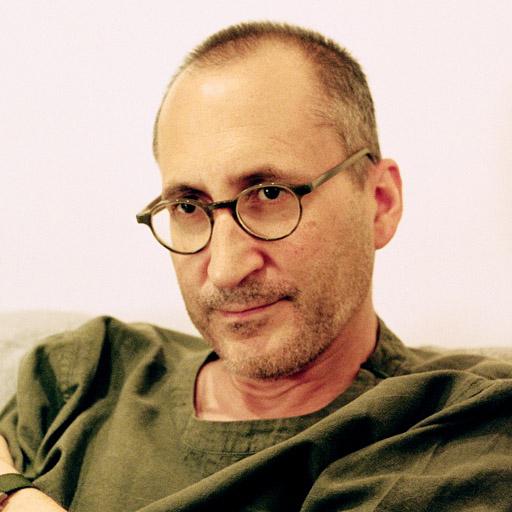
Christopher Lloyd Salter, PhD
- Professor Emeritus, Design and Computation Arts
- University Research Chair in New Media, Technology and the Senses
- Co-Director, Hexagram Network for Research-Creation in Media Arts, Design, Technology and Digital Culture
- Director, Hexagram Concordia
- Associate Director, Milieux Institute for Arts, Culture and Technology
- Director, xmodal
Are you the profile owner?
Sign in to editResearch areas: immersion, machine learning, new media theory, STS, performance, haptics, senses, embodiment, digital audio, sensory studies, sensory ethnography, interaction design, media art history, sound design, critical AI studies, posthumanism, philosophy of technology, enactive cognition, research-creation
Contact information
Biography
Biography
Chris Salter is an artist, University Research Chair in New Media, Technology and the Senses, Professor of Computation Arts in the Department of Design and Computation Arts, Co-Director of the Hexagram Network for Research-Creation in Media Art, Design, Digital Culture and Technology, Director of Hexagram Concordia and Associate Director, Milieux Institute for Arts,Culture and Technology.
Salter studied economics and philosophy at Emory University and received his Ph.D. in theater directing and dramatic theory/criticism at Stanford University where he also worked and researched at CCRMA (Center for Computer Research in Music and Acoustics). At Stanford, Salter studied with former Brecht assistant Carl Weber as well as pioneers of digital synthesis John Chowning, Max Matthews and Chris Chafe. In the 1990s, he collaborated with theater director Peter Sellars and choreographer William Forsythe/Frankfurt Ballet. He was visiting professor in music, graduate studies and digital media at Brown University and the Rhode Island School of Design (RISD) before joining Concordia University’s Faculty of Fine Arts in 2005. He was also Guest Professor at the KhM in Cologne in 2010 and is continuing Guest Faculty at the Masters program in Media Arts History, Institute für Bildwissenschaften,Donau University, Krems, Austria.
Salter’s large scale installations, performative environments and research focuses on and challenges human perception, merging haptic, visual, acoustic and other sensory phenomena. Exploring the borders between the senses, art, design and new technologies, his immersive and physically experiential works are informed by theater, architecture, visual art, computer music, perceptual psychology, cultural theory and engineering and are developed in collaboration with anthropologists, historians, philosophers, engineers,artists and designers.
His work has been shown at major international exhibitions and festivals in over a dozen countries including the 2008 Venice Architecture Biennale (Venice), Wiener Festwochen (Vienna), Berliner Festspiele/Martin Gropius Bau (Berlin), Musée d’Art Contemporain (Montréal),National Art Museum of China (Beijing), Lille 3000 (Lille), Chronus Art Centre (Shanghai), Fondarie Darling (International Biennale of Electronics Arts – Montreal),HAU3 (Berlin), Laboral Centro de Arte y Creacion Industriel (Gijon, Spain),Nuit Blanche (Paris), Vitra Design Museum (Germany), EXIT Festival (Maison des Arts, Creteil-Paris), STRP Biennale (Eindhoven), Ars Electronica (Linz), Pact Zollverein (Essen, Germany), CTM (Berlin), Villette Numerique (Paris),TodaysArt (the Hague), Todays Art.jp (Tokyo), Meta.Morf (Norway), MoisMulti(Quebec), Transmediale (Berlin), Place des Arts (Montréal), Elektra(Montréal),the Banff Center (Banff), Dance Theater Workshop (New York), V2(Rotterdam), SIGGRAPH 2001 (New Orleans), Mediaterra (Athens) and the Exploratorium (SanFrancisco), among others.
Salter is a regular presenter at national and international conferences, has given over 100 invited talks at universities and festivals worldwide and has sat on many juries including the Prix Ars Electronica among others. In addition to his artistic work, he is the author of the seminal book Entangled: Technology and the Transformation of Performance (MIT Press, 2010) and Alien Agency: Experimental Encounters with Art in the Making (MIT Press, 2015).
Education
- PhD - Theatre and Computer-Generated Sound, Stanford University
- BA Magna Cum Laude - Economics and Philosophy, Emory University
Areas of expertise
New Media and the Senses, Digital audio, sound design, real time performance, sensors, responsive environments, new media theory and history, theory/history of performativity and technology.
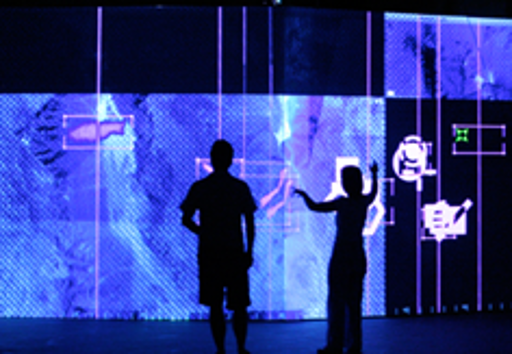
Air XY - Erik Adigard+Chris Salter, Venice Biennale (Architecture), 2008
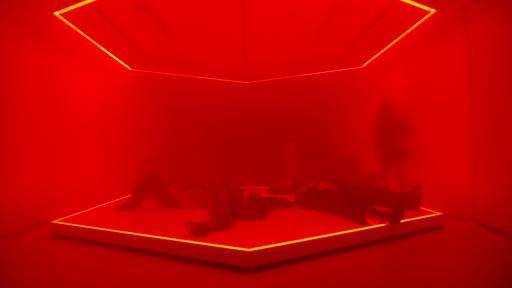
Displace, V.2 - The Hague, 2012
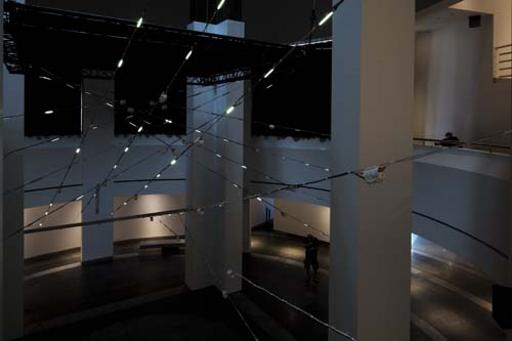
N-Polytope: Behaviors in Light and Sound After Iannis Xenakis - MAC Montreal, 2017
thomas spier/apollovision.de
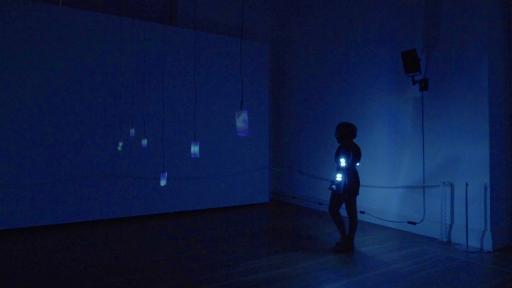
Haptic Field, Berliner Festspiele, Martin Gropius Bau, Berlin, 2017
Rasmus Bell
Publications
Alien Agency: Experimental Encounters with Art in the Making
In Alien Agency, Chris Salter tells three stories of art in the making. Salter examines three works in which the materials of art—the “stuff of the world”—behave and perform in ways beyond the creator’s intent, becoming unknown, surprising, alien. Studying these works—all three deeply embroiled in and enabled by science and technology—allows him to focus on practice through the experiential and affective elements of creation. Drawing on extensive ethnographic observation and on his own experience as an artist, Salter investigates how researcher-creators organize the conditions for these experimental, performative assemblages—assemblages that sidestep dichotomies between subjects and objects, human and nonhuman, mind and body, knowing and experiencing.
Salter reports on the sound artists Bruce Odland and Sam Auinger (O A) and their efforts to capture and then project unnoticed urban sounds; tracks the multi-year project TEMA (Tissue Engineered Muscle Actuators) at the art research lab SymbioticA and its construction of a hybrid “semi-living” machine from specially grown mouse muscle cells; and describes a research-creation project (which he himself initiated) that uses light, vibration, sound, smell, and other sensory stimuli to enable audiences to experience other cultures’ “ways of sensing.” Combining theory, diary, history, and ethnography, Salter also explores a broader question: How do new things emerge into the world and what do they do?
Entangled: Technology and the Transformation of Performance
This ambitious and comprehensive book explores technology’s influence on artistic performance practices in the twentieth and twenty-first centuries. In Entangled, Chris Salter shows that technologies, from the mechanical to the computational--from a “ballet of objects and lights” staged by Diaghilev’s Ballets Russes in 1917 to contemporary technologically-enabled “responsive environments”--have been entangled with performance across a wide range of disciplines. Salter examines the rich and extensive history of performance experimentation in theater, music, dance, the visual and media arts, architecture, and other fields; explores the political, social, and economic context for the adoption of technological practices in art; and shows that these practices have a set of common histories despite their disciplinary borders.
Each chapter in Entangled focuses on a different form: theater scenography, architecture, video and image making, music and sound composition, body-based arts, mechanical and robotic art, and interactive environments constructed for research, festivals, and participatory urban spaces. Salter’s exhaustive survey and analysis shows that performance traditions have much to teach other emerging practices--in particular in the burgeoning fields of new media. Students of digital art need to master not only electronics and code but also dramaturgy, lighting, sound, and scenography. Entangled will serve as an invaluable reference for students, researchers, and artists as well as a handbook for future praxis.

